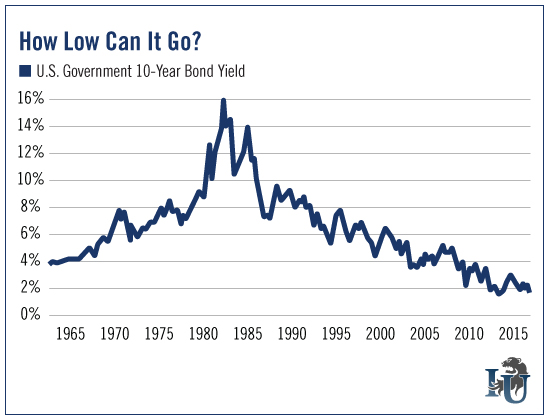
The drop in U.S. Treasury yields continues.
A little over a week ago, the yield on the 10-Year Treasury hit a three-year low of 1.57%.
This week’s chart shows you what rate Uncle Sam has been willing to pay lenders over the last 50 years. As you can see, yields are down more than 88% since peaking in the early ‘80s.
It makes you wonder... how much lower can yields go?
To answer that, we need to only look around. The German 10-Year bond currently pays 0.23%. Or, if you are really feeling charitable, you can lend your money to Switzerland at a -0.302% rate.
That’s right, you have to pay the Swiss government for the honor of lending them money.
And last week - for a split second - Japan’s yield went negative. The Bank of Japan announced in January that it was cutting its key rate to below zero, and government bonds followed suit.
It’s part of the new low interest rate world our Editorial Director has been railing against. (In fact, he recently went so far as to pen a “love note” to Federal Reserve chair Janet Yellen...)
In an effort to spur growth and inflation, global central banks are in a historic rate-cutting race. The journey to the bottom has already led some into negative territory.
And now the possibility of negative rates in the U.S. has become real. JPMorgan Chase (NYSE: N:JPM) and Bank of America (NYSE: N:BAC) put the probability of rates going negative by the end of 2017 at 13%.
That might not seem high, but it’s up from a 2% chance just a month ago. And that number could go higher if the global economic slowdown continues.
Fed chair Janet Yellen has already hinted at the possibility of negative rates. In a Congressional hearing last week, she stated, “We’re taking a look at them... I wouldn’t take those off of the table.”
All of this is unchartered territory for the monetary puppeteers. But you’re unlikely to hear too many governments complaining.
Think about it. Imagine if someone wanted to lend you money for absolutely nothing in return. Or, even better, they want to pay you to borrow from them...
You’d say “sign me up,” right?
That is the central bank’s hope. Lower rates should stimulate lending, borrowing, spending and perhaps the overall economy.
We will see if this works out in the end. But for now, what a deal for governments. Debt has been snowballing for decades. Now the snowball can grow at a much slower rate. And you get to pay your biggest lenders - taxpayers - a lower rate in the process...
Of course, it sounds like “We the People” are getting the short end of the stick. But there is a silver lining here...
As you can see in the chart above, 30-year mortgage rates move almost in lockstep with Treasury yields. Subsequently, you can now buy or refinance a home at a historically low rate.
I closed on a house just six months ago. And last week I refinanced to take advantage of these ultra-low rates. Now I’m locked in below 3.7%.
It’s not the same rate the U.S. government gets, but it’s still historically low for mortgage rates. When my parents bought their first house, they were happy to get a rate around 15%.
And if you are concerned about the real estate bubble that popped in 2008, allow me to provide some perspective...
Over the long run, real estate prices tend to rise. Median home prices are up 61.85% since 2000. Even amidst one of the worst recessions the U.S. has ever seen, housing prices are up in the last 15 years.
In this low interest rate world, real estate is simply one of the best investments you can make. Does that mean you need to go out and buy a new home? Not necessarily. But refinancing the one you’re living in now would likely be a smart move.

